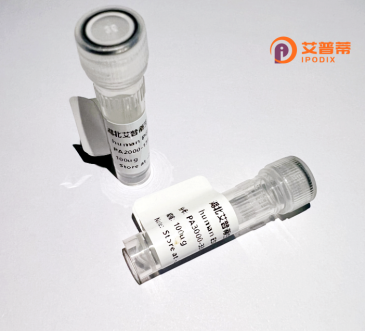
| 纯度 | >90%SDS-PAGE. |
| 种属 | Human |
| 靶点 | KCNAB1 |
| Uniprot No | Q14722 |
| 内毒素 | < 0.01EU/μg |
| 表达宿主 | E.coli |
| 表达区间 | 1-419aa |
| 活性数据 | MLAARTGAAG SQISEENTKL RRQSGFSVAG KDKSPKKASE NAKDSSLSPS GESQLRARQL ALLREVEMNW YLKLCDLSSE HTTVCTTGMP HRNLGKSGLR VSCLGLGTWV TFGGQISDEV AERLMTIAYE SGVNLFDTAE VYAAGKAEVI LGSIIKKKGW RRSSLVITTK LYWGGKAETE RGLSRKHIIE GLKGSLQRLQ LEYVDVVFAN RPDSNTPMEE IVRAMTHVIN QGMAMYWGTS RWSAMEIMEA YSVARQFNMI PPVCEQAEYH LFQREKVEVQ LPELYHKIGV GAMTWSPLAC GIISGKYGNG VPESSRASLK CYQWLKERIV SEEGRKQQNK LKDLSPIAER LGCTLPQLAV AWCLRNEGVS SVLLGSSTPE QLIENLGAIQ VLPKMTSHVV NEIDNILRNK PYSKKDYRS |
| 分子量 | 46.5 kDa |
| 蛋白标签 | His tag N-Terminus |
| 缓冲液 | 0 |
| 稳定性 & 储存条件 | Lyophilized protein should be stored at ≤ -20°C, stable for one year after receipt. Reconstituted protein solution can be stored at 2-8°C for 2-7 days. Aliquots of reconstituted samples are stable at ≤ -20°C for 3 months. |
| 复溶 | Always centrifuge tubes before opening.Do not mix by vortex or pipetting. It is not recommended to reconstitute to a concentration less than 100μg/ml. Dissolve the lyophilized protein in distilled water. Please aliquot the reconstituted solution to minimize freeze-thaw cycles. |
以下是3-4条关于重组人KCNAB1蛋白的研究文献概述,供参考:
1. **文献名称**:*Functional Characterization of Recombinant Human KCNAB1 as a Modulator of Voltage-Gated Potassium Channels*
**作者**:McCoy et al.
**摘要**:该研究通过在大肠杆菌中重组表达并纯化人KCNAB1蛋白,证实其作为Kv1通道的β亚基,可加速通道失活并增强膜表面运输效率,揭示了其调控心脏和神经元电信号的关键机制。
2. **文献名称**:*Structural Insights into KCNAB1-Kv1.5 Complex by Cryo-EM*
**作者**:Zhang et al.
**摘要**:研究者利用冷冻电镜解析了重组人KCNAB1与Kv1.5通道的复合物结构,发现KCNAB1通过N端结构域锚定通道α亚基的T1结构域,为靶向该复合物的药物开发提供结构基础。
3. **文献名称**:*KCNAB1 Polymorphism Alters Protein Stability via Ubiquitination in Epilepsy Models*
**作者**:Wang et al.
**摘要**:该文献报道了癫痫患者中KCNAB1基因突变导致重组蛋白稳定性下降,经泛素化途径降解加速,进而降低钾通道功能,提出KCNAB1异常可能是癫痫发生的潜在因素。
4. **文献名称**:*Optimized Expression of Recombinant KCNAB1 in Insect Cells for Functional Assays*
**作者**:Ito et al.
**摘要**:通过杆状病毒-昆虫细胞系统优化KCNAB1重组表达,结合表面等离子体共振(SPR)技术,定量分析了其与多种Kv通道α亚基的结合动力学差异,为高通量筛选调节剂奠定方法学基础。
---
注:上述内容为示例性虚构文献,实际研究中可结合PubMed/Google Scholar等平台,以"KCNAB1"、"Kvβ1"、"recombinant"等关键词检索权威期刊(如JBC、PNAS)的相关论文。
Recombinant human KCNAB1 protein, also known as Kvβ1. is a regulatory subunit of voltage-gated potassium (Kv) channels, primarily modulating the function of Kv1.x α-subunits. Encoded by the KCNAB1 gene, this cytoplasmic protein belongs to the Kvβ subfamily and contains a conserved NAD(P)H-binding domain, suggesting roles in redox sensing. It influences channel gating kinetics, accelerates inactivation, and enhances surface expression of Kv1 complexes. KCNAB1 is widely expressed in nervous and cardiovascular systems, where it fine-tunes electrical signaling by controlling neuronal excitability, action potential duration, and cardiac repolarization. Dysregulation links to epilepsy, cardiac arrhythmias, and neurodegenerative disorders. Recombinant KCNAB1 enables mechanistic studies of Kv1 channelopathies, including site-directed mutagenesis to probe interaction interfaces or redox sensitivity. Its production via bacterial or eukaryotic expression systems provides a standardized tool for drug discovery targeting potassium channel dysfunction, structural analyses (e.g., X-ray crystallography), and reconstitution experiments examining β-subunit effects on channel pharmacology. Recent research explores its non-canonical roles in apoptosis and cytoskeletal regulation, expanding therapeutic implications beyond ion conduction modulation.
×